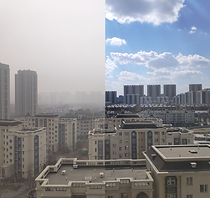
What's The Air Forecast?
Activity 5 (Explain): O3 Oh My! Getting to Know Ozone
Expand All
Collapse All
Switch to Dark Mode
Activity Summary
This shorter activity begins an opportunity for students to share what they know or have heard about ozone. After this, they watch a video and interpret an infographic to build their background knowledge about ozone. Students organize their understanding using a Venn diagram about different forms of ozone.
Activity Objectives & Materials
Approximate Time: 30 minutes
Objectives:
-
Students will understand what ozone is from both a general and chemical perspective
-
Students will understand the different between beneficial (stratospheric) and harmful (tropospheric) ozone
Materials:
-
Computer & projector
-
Speakers (for video)
-
Student computers (optional)
Handouts:
-
Ozone: Good up High, Bad Nearby Venn diagram
Standards Connection
DCI: ESS 3.C – Human Impacts on Earth’s Systems
DCI: ESS2.D – Weather & Climate
SEP: Obtaining, Evaluating, and Communicating Information
Warm-up
Primary air pollutants are pollutants that are released directly into the air from pollution sources. Ozone is not a primary pollutant, it is a secondary pollutant. Based on what you learned yesterday, why do you think ozone is called a secondary pollutant?
-
Ozone is a secondary pollutant because it is formed from a chemical reaction between different primary pollutants
-
The purpose of this warmup is to reinforce the idea that ozone is not emitted directly. This can be confusing for students, so it is worth emphasizing.
1. Frame the Activity
Tell students that now that they know that ground-level ozone was the cause of the haze in Washington on the Code Red day, we need to learn more about it as a pollutant. By learning where it comes from, we can work on ways to predict and prevent bad ozone days in the future. Today they’re going to study ozone in more depth to see what they can uncover.
2. What Do You Think?
Prepare a piece of chart paper (or a place on the board) to record student responses for this part of the activity. Then ask students what they know about ozone. Some may have heard about it, and it may be new to others. Record each answer on the board where all students can see. If students get stuck, prompt them with questions such as: “Is ozone good or bad?”, or “Where does ozone come from?” Don’t tell students which statements are accurate or inaccurate, just focus on letting them share. When students are finished sharing, tell them that you will come back to this list later as a class to see what they’ve learned.
The purpose of this part of the activity is to activate students’ background knowledge, and to see what students know about ozone. Students may have heard of the ozone layer before, and it is important to begin helping them to differentiate between ground-level ozone and stratospheric ozone.
3. Ozone: Good Up High, Bad Nearby
Hand out the ozone Venn diagram “Ozone: Good Up High, Bad Nearby” for students to take notes during the ozone video, and give students some time to consider what information they are looking for. Show them the video Ground Level Ozone: What is It? (below) or have them watch it using student computers. You may want to show it twice so students can fill in additional information on their graphic organizers. After they have finished, review the information on the graphic organizer to clear up any student misconceptions.
Differentiation: For advanced students: Give students a blank Venn diagram, have them take their own notes from the video, and then organize them using the diagram
4. Connecting Ozone to Emissions
Show students the graphic below from the US EPA.

Have students read the graphic and look at the pictures. Use the graphic to help strengthen the fact for students that ozone does not come directly from pollution sources like factories and power plants. Instead, the chemicals that come from these sources react using sunlight and heat to make ozone. Afterwards, have students add any additional information to the Venn diagram that is helpful.
5. I Used To Think, But Now I Think
Return to the “What Do You Think?” activity from the beginning of the lesson. Go through each of the statements you wrote down, and have students decide if it is true, partially true, or not true. If it is only partially true, have students turn to a partner and fix the statement by saying, “I used to think…<then the statement> but now I think…<what they’ve learned now>”. For example:
-
I used to think that ozone was bad for you, but now I think that only some ozone is bad for you and some is good for you.
-
I used to think that ozone was a layer high in the sky, but now I think that ozone can also be low to the ground.
Students can also add new statements if they want to show what they’ve learned during this activity.
Teacher Tip: Use the “I used to think…” part of the activity to prepare students to complete the formative assessment on the next page.
6. Formative Assessment
Have students return to their Investigation Trackers to add what they’ve learned about ozone. Key ideas:
-
There are two kinds of ozone: ground-level ozone and stratospheric ozone
-
Ground-level ozone (tropospheric) is a harmful pollutant that can hurt people’s lungs and damage crops
-
Stratospheric ozone (in the ozone layer) protects Earth from harmful radiation
-
Ground-level ozone is formed when certain kinds of air pollution react with heat and sunlight
-
You can prevent ozone from forming by using less electricity and driving less
Teacher Tip: Checking students’ completed Venn diagrams is another way to assess their understanding of ozone.